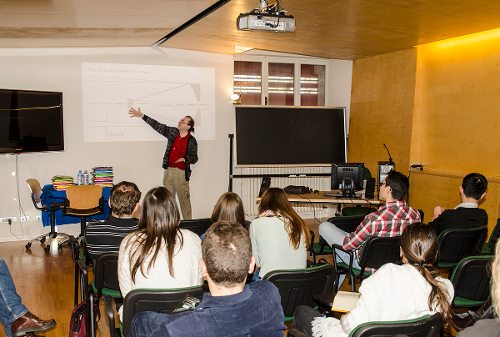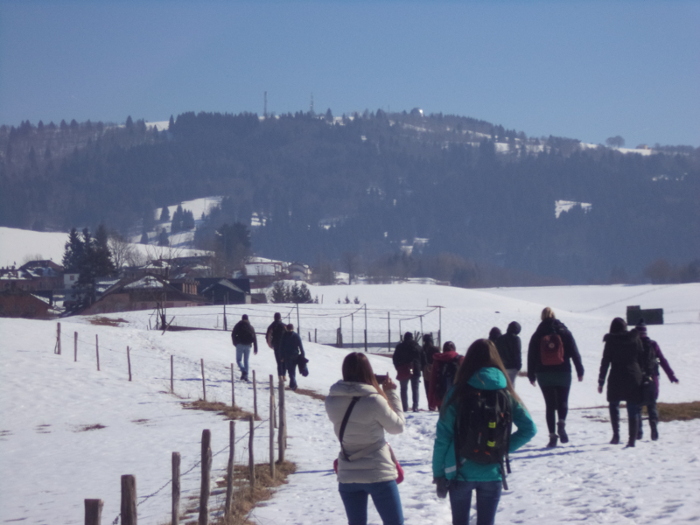The 2015 NEON winter school in Asiago (Italy)
The 2015 edition was the first NEON WINTER school, and
took place at the Asiago Observatory (Italy),
from Feb. 17h to 27th,
for observations and data reductions.
16 students, from 10 different countries, gathered first in
Venice airport in the afternoon of Feb. 17th,
to be transported by bus to the Asiago Observatory, where the school was taking place.
Some of them came from far away (as far as Ukraine or Turkey, or...the UK!) and although some of the flights
were cancelled due to a controler strike at the Marco Polo airport (it was the very day of the Carnaval...any relation?)
at the end everybody was collected one way or the other, thanks to the efficient help of Stefania from Asiago, and some had even a private ride with some of the lecturers!
A good (but late...) aperitif welcomed everybody to the Pennar Hotel where we would be staying for 10 days.
to be transported by bus to the Asiago Observatory, where the school was taking place.
Some of them came from far away (as far as Ukraine or Turkey, or...the UK!) and although some of the flights
were cancelled due to a controler strike at the Marco Polo airport (it was the very day of the Carnaval...any relation?)
at the end everybody was collected one way or the other, thanks to the efficient help of Stefania from Asiago, and some had even a private ride with some of the lecturers!
A good (but late...) aperitif welcomed everybody to the Pennar Hotel where we would be staying for 10 days.
The next day, as usual, the
school started with some lectures on fundamentals for
observations.
This started with a lecture on telescope optics and imaging, given by Roberto Ragazzoni (Padova), an expert who had worked with many telescope projects, including the Large Binocular Telescope in Arizona.
The introduction to spectroscopic techniques was given by Michel Dennefeld (Paris), who described the
classical case of long-slit spectroscopy (to be used later-on during the school) but gave also an overview of all the other techniques, including the ones used at the VLT, such as the Multi-Object Spectroscopy and Integral Field Spectroscopy.
Sergio Ortolani (Padova) then described the beauty, and difficulties, of Photometry, which is an essential complement
to spectroscopy, specially for the programs envisaged during this school.
Indeed, while basic imaging and spectroscopic observing was on the program as usual, the organisers had decided
this time to give a bit more emphasis on classification of astrophysical objects.
This because we are in an era where many all-sky surveys are going on, discovering plenty of variable objects
which need to be classified with the help of ground-based follow-up.
These first lectures were complemented by a presentation of the principles of stellar classification by H. Korhonen (Turku), who also provided the students with a few practical exercises to try their skills in classification.
And U. Munari (Padova) described the details of 1D spectral reduction, with a few exemples of Novae classification.
This started with a lecture on telescope optics and imaging, given by Roberto Ragazzoni (Padova), an expert who had worked with many telescope projects, including the Large Binocular Telescope in Arizona.
The introduction to spectroscopic techniques was given by Michel Dennefeld (Paris), who described the
classical case of long-slit spectroscopy (to be used later-on during the school) but gave also an overview of all the other techniques, including the ones used at the VLT, such as the Multi-Object Spectroscopy and Integral Field Spectroscopy.
Sergio Ortolani (Padova) then described the beauty, and difficulties, of Photometry, which is an essential complement
to spectroscopy, specially for the programs envisaged during this school.
Indeed, while basic imaging and spectroscopic observing was on the program as usual, the organisers had decided
this time to give a bit more emphasis on classification of astrophysical objects.
This because we are in an era where many all-sky surveys are going on, discovering plenty of variable objects
which need to be classified with the help of ground-based follow-up.
These first lectures were complemented by a presentation of the principles of stellar classification by H. Korhonen (Turku), who also provided the students with a few practical exercises to try their skills in classification.
And U. Munari (Padova) described the details of 1D spectral reduction, with a few exemples of Novae classification.
 |
|
The
lecture on telescope optics by R. Ragazzoni
|
to prepare the scientific program for the observations, and make the necessary technical choices for the instrument set-up. The available telescopes were the 1.82m Ritchey-Chretien telescope for spectroscopy or imaging, and the 1.2m for spectroscopy with a B&C spectrograph.
Each group had initially one night at each of the telescopes, but as the weather was very fine at the beginning, it was decided to divide the long winter nights in two, to ensure that everybody got the minimum of data necessary for their project. This proved very wise, as the weather degraded soon thereafter...
But although the telescopes can be remote controlled, a detailed visit was payed also to each of them, to understand the details of the optics and the instrument set-up. And the remote-control proved to be very useful, once the snow had covered the road going up to the telescope...

|
|
Some scientific lectures were
also given, once the observations had terminated.
C. Barbieri (Padova) gave the latest news about the Rosetta mission, as the OSIRIS camera
had been built under Italian leadership. M. Turratto (Padova) explained the details of Supernovae
classification, as this topic is one of the main (and successful!) work-programs of the Asiago telescopes,
and was also on the program of this school.
And P. Rafannelli (Padova) did the same about AGN classification, another successful program of the observatory, and topic during the school.
Finally, after hard and intensive work, and many back and forth between the observatory and the hotel, the scientific results were presented on the last day of the school.
The group lead by A. Siviero (Padova), with Luca Costantin (Padova), Estela Fernandez (Granada), Helen Jermak (Liverpool) and Michael Mach (Vienna) tried to classify several stars selected as potentially peculiar from the RAVE survey. They showed indeed that all those spectra had Halpha emission, and displayed also some emission over the Calcium absorption, hence demonstrating some chromospheric activity.
The group lead by L. Morelli (Padova), with Sara Bulut (Kayseri), Rosa Dimitrova (Sofia), Michalis Kourniotis (Athens) and Manuel LLamas (Madrid) analysed the galaxy IC471 and showed, by combining photometry and spectroscopy, that it was dominated by an old stellar population, consistent with a classification as an elliptical galaxy.
The group lead by J. Mendez (St Andrews), with Emmanuel Bernhard (Sheffield), Tatiana Hromakina (Karkhiv), Michal Pawlak (Warsaw) and Megan Whewell (London) tried to classify several galaxies from the SDSS survey.
They identified one blazar (no emission lines), one Seyfert 2 and on star-forming galaxy, whose Halpha flux was
indicating formation of several solar masses per year. They were however limited by the weather and could not obtain all the information they would have wished about the metallicity of this object.
Finally, the group led by Nancy Elias-Rosa (Padova), which comprised Demetra de Cicco (Napoli), Marco Lam (Edimburgh), Ignacio Ordovas (Santander) and Paulina Sowicka (Warsaw), took spectra of several recent or new SuperNovae candidates. They confirmed the classification of SN 2015D as a type II, thanks to the PCygni profile seen in the Halpha emission line and showed that the possible SN in NGC 238 was in fact a Ibn, with narrow HeI lines.
The CSS candidate 100134+4533 was classified for the first time, proving to be a type Ia about one week after maximum, with ejection velocities about 11,000 km/s.
This result was published in an Astronomical Telegram (ATel 7120, Feb. 21, 2015)
C. Barbieri (Padova) gave the latest news about the Rosetta mission, as the OSIRIS camera
had been built under Italian leadership. M. Turratto (Padova) explained the details of Supernovae
classification, as this topic is one of the main (and successful!) work-programs of the Asiago telescopes,
and was also on the program of this school.
And P. Rafannelli (Padova) did the same about AGN classification, another successful program of the observatory, and topic during the school.
Finally, after hard and intensive work, and many back and forth between the observatory and the hotel, the scientific results were presented on the last day of the school.
The group lead by A. Siviero (Padova), with Luca Costantin (Padova), Estela Fernandez (Granada), Helen Jermak (Liverpool) and Michael Mach (Vienna) tried to classify several stars selected as potentially peculiar from the RAVE survey. They showed indeed that all those spectra had Halpha emission, and displayed also some emission over the Calcium absorption, hence demonstrating some chromospheric activity.
The group lead by L. Morelli (Padova), with Sara Bulut (Kayseri), Rosa Dimitrova (Sofia), Michalis Kourniotis (Athens) and Manuel LLamas (Madrid) analysed the galaxy IC471 and showed, by combining photometry and spectroscopy, that it was dominated by an old stellar population, consistent with a classification as an elliptical galaxy.
The group lead by J. Mendez (St Andrews), with Emmanuel Bernhard (Sheffield), Tatiana Hromakina (Karkhiv), Michal Pawlak (Warsaw) and Megan Whewell (London) tried to classify several galaxies from the SDSS survey.
They identified one blazar (no emission lines), one Seyfert 2 and on star-forming galaxy, whose Halpha flux was
indicating formation of several solar masses per year. They were however limited by the weather and could not obtain all the information they would have wished about the metallicity of this object.
Finally, the group led by Nancy Elias-Rosa (Padova), which comprised Demetra de Cicco (Napoli), Marco Lam (Edimburgh), Ignacio Ordovas (Santander) and Paulina Sowicka (Warsaw), took spectra of several recent or new SuperNovae candidates. They confirmed the classification of SN 2015D as a type II, thanks to the PCygni profile seen in the Halpha emission line and showed that the possible SN in NGC 238 was in fact a Ibn, with narrow HeI lines.
The CSS candidate 100134+4533 was classified for the first time, proving to be a type Ia about one week after maximum, with ejection velocities about 11,000 km/s.
This result was published in an Astronomical Telegram (ATel 7120, Feb. 21, 2015)
 NEON
NEON